Volume 19, Issue 2
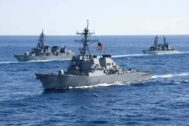
Regional Overview
May — August 2017Continuity (and Anxiety) Continue
In our last issue we argued that there had been more continuity than change in America’s Asia policy. The Trump administration’s senior national security team has tried to prove us right over the past four months. Defense Secretary James Mattis noted that the Asia Pacific remained “a priority region” for the US. Secretary of State Rex Tillerson reaffirmed the US commitment to democracy and human rights while laying out Washington’s “peaceful pressure” policy against Pyongyang. Acting Assistant Secretary of State Susan Thornton said that America’s “active engagement [in Asia] is frankly continuing and is not going to be changing anytime soon.” The major exception was the abandonment of the Trans-Pacific Partnership (TPP) and the president’s frontal attack on “bad” trade deals. These attacks, against the Korea-US Free Trade Agreement (KORUS) and the North America Free Trade Agreement (NAFTA) have continued, although the US has not (yet) withdrawn from either accord. The final statements from two major economic gatherings in recent months, the G7 and G20 Summits, endorsed the principles of free trade, although this was despite, rather than because of, the US, which used to champion this cause. The absence of US leadership has compelled others to speak up and carry the ball.

US - Japan
May — August 2017A Summer of Setbacks
The summer of 2017 was an uneasy one in both Tokyo and Washington. In Japan, Prime Minister Abe Shinzo struggled as public approval dropped precipitously following scandals and a miserable performance for his party in the Tokyo metropolitan elections. In the US, President Donald Trump moved from conflict to conflict, resulting in a historically low approval rating for a new administration and deep fissures within the Republican Party. Alliance cooperation largely focused on the continuing tensions with North Korea. A long-awaited Japan-US Security Consultative Committee (2+2 Meeting) between the defense and foreign policy principals could not be scheduled until after Abe reshuffled his Cabinet in August. While the discussions proved cordial, there was little indication that a strategic look ahead was in the making. Troubles at home for both administrations seemed to forestall any effort at a comprehensive US-Japan discussion about the Asia-Pacific region.
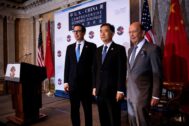
US - China
May — August 2017North Korea and Trade Dominate the Agenda
The Trump administration’s focus on increasing pressure on North Korea to abandon its nuclear and missile programs kept that issue at the top of the US-China agenda. In phone calls and a meeting between Presidents Trump and Xi Jinping on the margins of the G20 Summit, at the Diplomatic and Security Dialogue, and at the ASEAN Regional Forum, North Korea received the greatest attention as the US urged Beijing to use its economic leverage against Pyongyang in a bid to change Kim Jung Un’s calculus. After a seven-month hiatus, the US resumed freedom of navigation (FON) operations in the South China Sea, conducting one operation in the Spratly Islands in May and another in the Paracel Islands in July. Marine Corps Gen. Joseph Dunford made his first visit to China as chairman of the US Joint Chiefs of Staff. The first Comprehensive Economic Dialogue convened, but made little progress in easing bilateral economic friction. In August, the Trump administration formally initiated a Section 301 investigation into China’s theft of intellectual property.
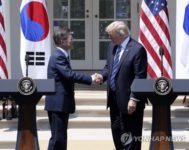
US - Korea
May — August 2017Missiles Fire and Fury
Tensions rose to new levels on the Korean Peninsula as North Korea fired multiple missiles demonstrating markedly enhanced capabilities and crowned the Labor Day weekend with a sixth nuclear test with a significantly larger yield than previous tests. The United States tackled its most significant global security challenge by reinforcing its deterrent capabilities, tightening the financial noose on the North, President Trump tweeting stern warnings, and military and diplomatic leaders calling for dialogue. South Korea responded by reiterating its military readiness, expanding its own missile capabilities, and reeling from Trump’s rhetoric that likened President Moon Jae-in’s push for talks to “appeasement” and his threat to scrap the KORUS trade agreement. Despite joint military exercises, live fire drills, B-1 dispatches, and shared statements condemning Pyongyang to signal alliance strength, the relationship between the United States and South Korea appears frayed in dramatic new ways.
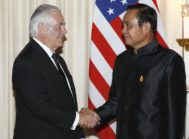
US - Southeast Asia
May — August 2017Regional Skepticism
Unlike its predecessor, the Trump administration has not devoted much attention to Southeast Asia; there is no clear policy toward the region. Instead, two areas have been emphasized: an increase in the number of Navy ship-days in the South China Sea and regular economic pressure on Southeast Asian states based on the president’s “America First” principle. Insofar as there is a security policy, it has been to gain support for Washington’s efforts to isolate North Korea. US relations with the Philippines have improved because there have been limited complaints about President Duterte’s war on drugs and increased support for the Philippine Armed Forces’ counterterrorism actions in Mindanao. Vietnam Prime Minister Nguyen Xuan Phuc’s trip to Washington focused on reducing Hanoi’s trade surplus, and, in August, Secretary of Defense Mattis promised a visit by a US aircraft carrier to Vietnam, the first since the end of the Vietnam War. Washington applauded the ASEAN-China agreement on a framework for a code of conduct for the South China Sea, urging that the actual code be legally binding, a stipulation opposed by China.
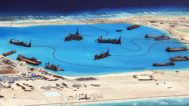
China - Southeast Asia
May — August 2017Steady Gains in South China Sea
Though periodically distracted by the North Korea crisis that intruded on deliberations during the ASEAN Regional Forum and other ASEAN meetings in Manila, China-Southeast Asia relations remained focused on the South China Sea. China and ASEAN reached agreement on a framework for a code of conduct in the South China Sea that supported Beijing interests. Modest advances in Chinese control of the territory and resources of the South China Sea continued while Beijing rebuffed Philippine and Vietnamese efforts to unilaterally drill for oil and gas in their exclusive economic zones that fall within China’s broad claim. Challenges posed by US freedom on navigation exercises and statements by US and allied leaders at odds with China’s policies and practices were dismissed as Chinese propaganda outlets highlighted Xi Jinping’s personal leadership in China’s success in the South China Sea amidst the hagiography for him prior to the 19th Party Congress that will be held this fall.
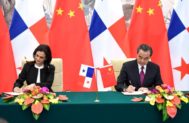
China - Taiwan
May — August 2017China Increases Pressure, Tsai Holds the Line
In the run-up to the 19th Party Congress, Beijing has pursued an inflexible policy toward Taiwan, consistently blocking its international participation, establishing diplomatic relations with Panama, and conducting military exercises around Taiwan. Despite such pressures, President Tsai, whose priorities are domestic economic and social reform, has not changed her policy that neither accepts nor explicitly challenges Beijing’s one-China principle, and she has urged Beijing to join in seeking a new formula. With the US Congress expressing increased support for Taiwan, the Trump administration approved a new arms sales package and took other steps to improve ties with Taiwan. Beijing has warned Washington about closer ties with Taipei, raising the prospect that Taiwan will again become a divisive issue in US-China relations. In the absence of dialogue, unstable and risky cross-strait relations will continue in the months ahead.
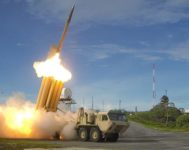
North Korea - South Korea
May — August 2017Has Kim Jong Un Made Sunshine Moonshine?
Despite dreaming that the inauguration of Moon Jae-in as the new president in South Korea would lead to an improvement in North-South relations, events over the summer of 2017 precluded any semblance of reconciliation on the Korean Peninsula. In the context of Kim Jong Un’s aggressive pursuit of the North’s ballistic missile and nuclear weapon programs, Moon’s olive branches were consistently rebuffed while Kim exchanged bombastic rhetoric with US President Donald Trump and thumbed his nose at the UN Security Council. By summer’s end, there was little prospect for a return to the “sunshine” era in the South. Instead, South Koreans were increasingly interested in having their own nuclear weapons and the South Korean military openly talking about a decapitation unit to deal with the North Korean leadership.
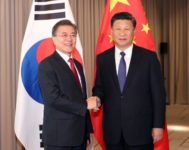
Days after Moon Jae-in’s presidential victory in Seoul on May 9, Pyongyang continued a series of missile tests that demonstrated the range and capability of its weapons, including an intercontinental ballistic missile capable of striking the United States. Early exchanges between Chinese leaders and the new Moon administration provided a chance to reset bilateral ties, including at Beijing’s Belt and Road Forum in June and South Korea’s hosting of the AIIB meeting in Jeju a month later. China supported the adoption of new UN Security Council Resolutions 2356 and 2371 on North Korea, pledging to enforce expanded sanctions and announcing domestic measures to enhance sanctions enforcement. The China-ROK strategic dialogue in June and the first Xi-Moon meeting in July, however, failed to narrow differences over THAAD, clouding Beijing and Seoul’s 25th anniversary celebrations of diplomatic normalization in August. Meanwhile, public attacks between Chinese and North Korean media indicate continued deterioration in the China-DPRK relationship.
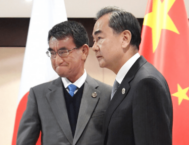
Japan - China
May — August 2017No Setbacks, No Progress
The pattern of warm trade and cold politics continued over the summer of 2017. No discernible progress was made in resolving issues between Japan and China. Leadership interaction was limited, while economic relations showed some signs of improving and tensions in the East China Sea dominated defense activity. At the end of September, the government-sponsored China Daily opined that it was “no exaggeration to say that the past five years have been among the darkest days in Sino-Japanese ties since the two established formal diplomatic ties.”

Japan - Korea
May — August 2017On Board for a Dual Track Approach
With the inauguration of Moon Jae-in in South Korea on May 10, relations between Seoul and Tokyo witnessed a significant turnaround over the summer months of 2017. In particular, the dispute over the “comfort women” agreement reached in 2015 escalated as the Moon administration reversed course, launching a task force on July 31 to review the agreement. Meanwhile, concerns that measures the Park administration had adopted to improve security ties with Japan might be revoked were dispelled when Seoul and Tokyo agreed to maintain close security cooperation on the North Korea issue. In addition, despite the continued tension over Dokdo/Takeshima and Japan’s wartime crimes, Seoul and Tokyo chose to “pursue forward-looking relations” through diplomatic exchanges. Given that the Moon administration has indicated that it wants relations to go smoothly regardless of the comfort women issue, we expect diplomatic exchanges and security cooperation to continue. Sustained improvement will depend on South Korea’s “final” decision on the 2015 comfort women agreement.
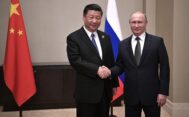
China - Russia
May — August 2017“Best and Worst Time” for Beijing and Moscow?
Between April and early September, top Chinese and Russian leaders met four times: in Beijing (BRI Summit), Astana (SCO Summit), Moscow (Xi’s official visit), and Xiamen (BRICS Summit). Each time, Xi and Putin hammered on the “best-ever” theme for Sino-Russian relations. Meanwhile, the two militaries signed a four-year guideline for military cooperation and conducted their first naval exercise in the Baltic Sea. The world according to Beijing and Moscow, however, was being turned upside-down and inside-out as threats of nuclear war were hurled between the US and North Korea. Moscow and Beijing tried hard to coordinate their Korea policies. In May, China’s Belt and Road Initiative (BRI) Forum received Russia’s public if not enthusiastic support. India’s unambiguous objection, however, turned out to be the precursor to a protracted standoff between India and China over a remote road on the Doklam plateau. The crisis was defused only a few days before the BRICS Summit in Xiamen. Few, if any, of those gathered at the summit’s 10th anniversary expected to be jolted by North Korea’s hydrogen bomb test on Sept. 3. Welcome to a brave new world of strong, and sometimes strange, leaders whose decisions have serious consequences for the world.
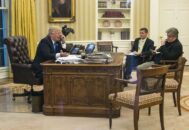
Australia-US/East Asia
May — August 2017The Donald Dichotomy: US Leadership Without the Leader
The uncertainty generated by President Donald Trump has made Australia cling ever tighter to the US alliance. The Trump effect hit Canberra within days of Trump taking office. The phrase “shock and awe” springs to mind – rendered in the alliance realm as “shake and appall.” The first phone conversation between Trump and Prime Minister Malcolm Turnbull was a version of “shake, rattle and roll.” Canberra wants to play nice with The Donald, and say nothing publicly that is critical of the president. The template for the Australian approach was on display early when the president withdrew the US from the Trans-Pacific Partnership. The Turnbull government expressed great regret at the decision but said nothing about the man who’d made it. While striving not to affront the president, Australia’s language about China has become shriller. Tongue-tied by Trump, Canberra gives stronger voice to concerns about China. Turnbull has referred to the “dark view” of a “coercive China” seeking Asia domination. Stern words about China’s threat to the rules-based system serve a dual purpose: speak to Beijing about the value of the system while implicitly pleading with the US not to abandon what it has built and policed – and mightily profited from.